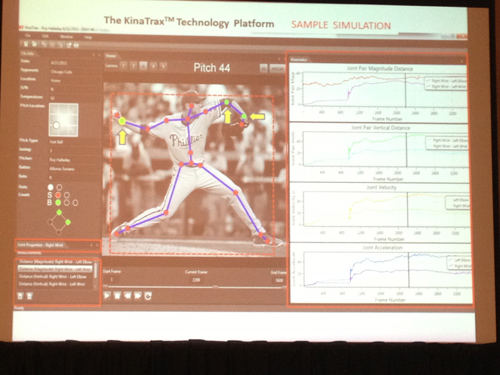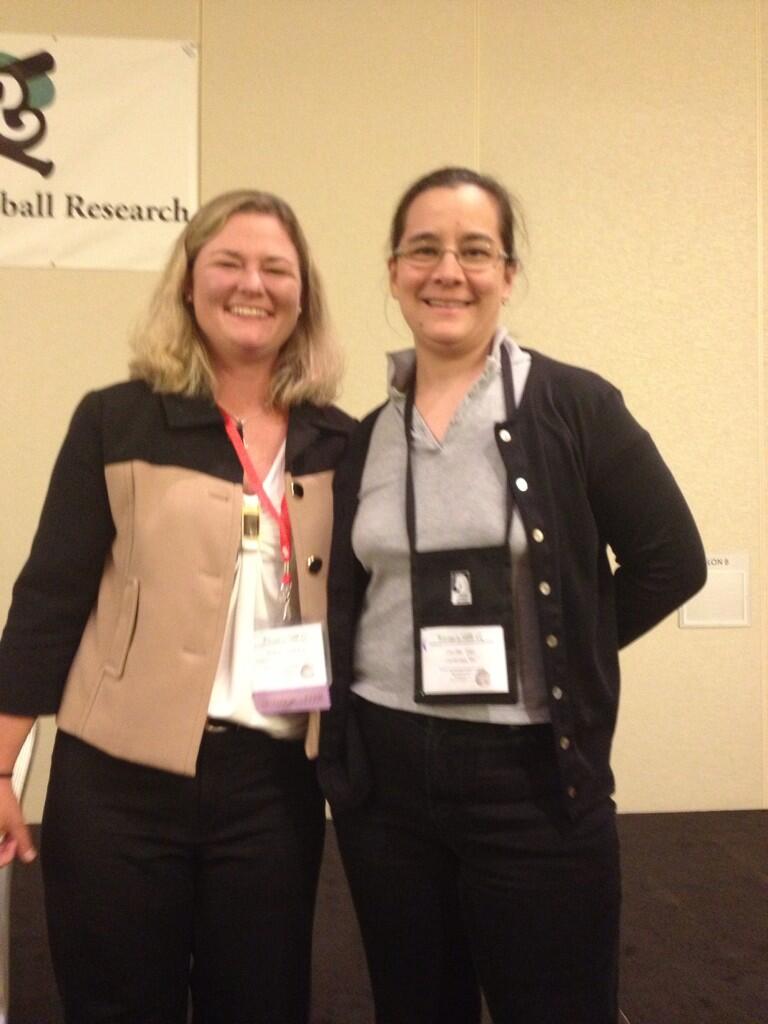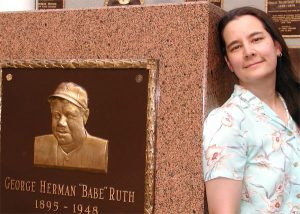Hello, my baseball-loving friends. I’m at the annual SABR national convention, where the presentations, research, connections, and interests run both wide and deep.
Unlike in some past years, where I’ve literally taken in 5-6 research presentations AND liveblogged the keynotes and panel discussions, this time I’m having to slow down a little. I was so tired this morning I had to sleep through the SABR business meeting and the keynote opening by Phillies CEO David Montgomery. (Fortunately for me, Montgomery’s speech can be heard live on SABR.org. The audio and a recap can be found here: http://sabr.org/latest/sabr-43-listen-phillies-ceo-david-montgomerys-opening-remarks).
The result was I started my day not with a brain-bending dose of stats or an eye-opening look at a sliver of fascinating baseball history, but with a bowl of crawfish ettouffee from Beck’s Cajun stand in the Reading Terminal Market, which is right across the street from the hotel. It was pouring down buckets, but I brought an umbrella with me!
I may have to accept the data that my umbrella-carrying habits are not, in fact, causal to the weather. Usually if I bring an umbrella it doesn’t rain, but if I forget one, we get poured on. This time I brought one and it poured, but the good news is… that meant I had an umbrella in the rain. The ettouffee was delicious and very filling.
Then I saw three presentations:
* RP06: Rube Waddell and the Great Straw Hat Mystery of 1905
* RP12: A Probabilistic Approach to Measuring the Excitement of Baseball Games
* RP14: Markerless Motion Capture Technologies For In-Game Player Performance Assessment
STRAW MAN
The first presentation I actually made it to was Steven A. King on the great Rube Waddell Straw hat Controversy of 1905. The common wisdom story of Waddell is that he couldn’t pitch in the 1905 World Series because he hurt his arm in a fight with another player over a straw hat. This is about as plausible as the fact that Babe Ruth ate too many hot dogs, resulting in the “bellyache heard round the world.” (It’s more likely Ruth had syphilis.) What is not known is whether Waddell’s mystery injury was a true injury and the straw hat story was a cover for the true nature of it, or if the straw hat story was covering up the fact that Waddell had possibly been bought off by gamblers.
I was amused to see some outraged tweets from people who apparently didn’t like the besmirching of Waddell’s reputation. One was angry that the presenter didn’t cite sources. Apparently the guy had no idea that a 20-minute oral presentation isn’t the place to cite dozens of sources? I hereby point him to the 52 footnotes that follow Steven A. King’s article on this same topic, “The Strangest Month in the Strange Career of Rube Waddell,” which was just published in The National Pastime. The 52 footnotes is not the most for an article in a SABR publication, but it does put it in the top percentile. You can read the entire article online, along with the footnotes, here: http://sabr.org/research/strangest-month-strange-career-rube-waddell
OK, maybe I was just amused that people can be outraged over the reputation of a player who has been dead for 99 years.
GET EXCITED
I spent too much time wandering around in the vendor room, so I missed Dan Levitt’s presentation about the Federal League. Alas–I’ll have to read Dan’s book on the subject instead. (It’s The Battle that Forged Modern Baseball: The Federal League Challenge and Its Legacy and that link is to Amazon, btw.) The next one I made it to was “A Probabilistic Approach to Measuring the Excitement of Baseball Games” by Michael Freiman. This is one of those presentations that is uniquely SABR-ish. I know some who would criticize the basic effort in trying to quantify the unmeasurable. Excitement? Do we actually need to measure that? But those folks miss the point. Making metrics is one way to dig deeper into the mechanisms of the game. In this case Freiman is digging not only into the mechanisms of the game, but into one key component of the spectator experience, which is our expectation or rooting for a win or a loss.
His premise is fairly simple. Every event in every game contributes or detracts from a team winning or losing the game, and can be measured in percentage points of change in the probability of winning or losing. For Game Excitement Index he extends this concept to measuring how likely the team is to win or lose the World Series. (He also mentioned he adapted this metric from a measure in a paper on soccer in the Journal of Quantitative Analysis in Sports by Vecer, Ichaba, and Laudanovic.) The idea is that if something happens that swings the probability from one team to another, that’s exciting, and if it swings back again, that’s even more exciting. Pulling defeat from the jaws of victory, etc…
He proceeded to give a top 20 list of the most exciting games in postseason history, which were mostly game 6 or 7 of the World Series, but one NLCS entry did make it: NLCS Game 5 in 1980, “possibly most exciting postseason game on a per inning basis ever.” He also looked at some specific historic moments like Bobby Thomson’s “shot heard ’round the world.” When it comes to “winner take all” games it is the 17th best of all time.
He acknowledged that “excitement” is an inherently subjective thing, and that this method can’t take into account things like the context of the game or drama generated by off-field factors, non-play elements (Gibson being injured when he limped to the plate, outs being made by spectactular catches). “In principal you can imagine a system that took these things into account, but in practice how you measure these things is not clear.” He welcomes comments at michael.freiman@gmail.com
MOTION IN MOTION
Michael Eckstein from Kinatrax gave a presentation about how motion-capture technology is leaping forward and how it applies to baseball. Much of what he presented was visual, but here are the main points he made about Kinatrax and how we reached this state of MoCap technology:
Eckstein: “We all understand that baseball is a game of mechanics. Mechanics is repetition, doing time and time again what works. Kinatrax is a company that focuses on the analytics of motion.”
He describe that traditionally, marker motion capture systems put a person into a Spandex suit with little reflective balls attached to it. (If you’ve seen the Lord of the Rings DVD extras, you see a lot of Andy Serkis wearing one.) To make the Tiger Woods golf video game, they put Tiger Woods in the suit and built his avatar on that.
But if you have an Xbox at home, you don’t put on one of those suits to use it. You swing your arm standing in front of the Microsoft Kinect and you see your tennis racquet swing on the screen. That’s “markerless motion capture.”
Eckstein went on to show how with a six-camera setup you can model the human body completely in 3D, which is the setup NOW being used to make games like Halo 4 and most Hollywood animation. But that system can’t be used in baseball because it doesn’t capture enough frames per second, and the focal length of the cameras is only 8-14 feet. “How can we track a player in a game situation and report on the biomechanics of his motion?” he asked.
Enter Kinatrax and their new high speed cameras, which have a “split architecture, traditional sensor design, has fps speed needed, and good data transfer rate. We have matched these with new telephoto lenses.” Judging from his slides, the entire camera is fairly tiny, with a large lens on it.
Kinatrax records:
Distance
Angles
Velocity
Acceleration
The system maps joints, bones, and muscles, using 20 different points on the body. He showed a shot of what the system data might look like with Roy Halladay. (Here’s a photo by Colin Wyers of the screen: https://twitter.com/cwyers/status/363029091500322816/photo/1)
Here’s my not great cellphone photo of the sample data screen shown in the presentation:

They’re working with the Mets now to implement the system as their first MLB partner. They figured out where in Citi Field to put all the cameras. The idea is that they can rack up tons of data on a pitcher and identify a baseline of when he’s at his best. What does he look like when all his pitches are working? What’s the comparative biomechanics over the course of a pitcher’s career. Does his motion change based on situation? And can you identify early when an injury or a breakdown is imminent?
Eckstein: “We are not in any way trying to replaces coaches and trainers. We’re trying to give them a tool they can use to do their jobs and apply to their situation.”
Kinatax should have a full public proof of concept demo to present at SABR Analytics in 2014 in Arizona.
Some other notes:
Each pitch is 1.3 gigabytes of data. (Each pitch!!)
That means they generate 8-10 terabytes of information every game. They’re working with Microsoft and it’s all stored in the cloud. The data isn’t ready for viewing until 10 hours after the game.
Not yet able to zoom in on grip, pitcher position on the fingers on the ball, not there yet. Maybe someday.
Email meckstein@kinatrax.com if you want a copy of the presentation.
PANELS
There were also two major panels today, the player panel with Dickie Noles, Gary Matthews, and Brad Lidge, and the Women in Baseball panel, which featured the fantastic, legendary Perry Barber (the woman who came closest to umpiring a big league game), Salty Ferguson (who played with the Rockford Peaches of the AAGPBL), Susan Ingersoll Papaneri (from the Phillies front office), and Kristin Mills Caldwell, and moderated by Robin Wallace, both of whom played for the Team USA women’s baseball team. And Robin, by the way, is the woman who taught me to throw a baseball correctly, at the very first New England Women’s Baseball League practice/tryout I went to.
I livetweeted both panels. Here are links to the full Storify compilations of them:
Women in Baseball: http://storify.com/whyilikebb/sabr-43-player-panel
SABR 42 Phillies Player Panel: http://storify.com/whyilikebb/sabr-43-player-panel
Much much more coming tomorrow. Now that I work for SABR as Publications Director, these conventions are more and more like weddings where the bride only gets to see each guest for a few seconds. Got to say hi but not much more to some folks I’ve mostly known online and other many longtime SABR pals, including Howard Luloff, David Avins, Alex Bensky, Pete Cava, Larry Baldasarro, Tara Krieger, Evelyn Begley, Damien Begley, Steve Roney, Zita Carno, Barry Deutsch, not to mention my one of my favorite Baseball Prospectus writers in Colin Wyers, and SABR’s former Executive Director John Zajc! (And many more!)



Post a Comment